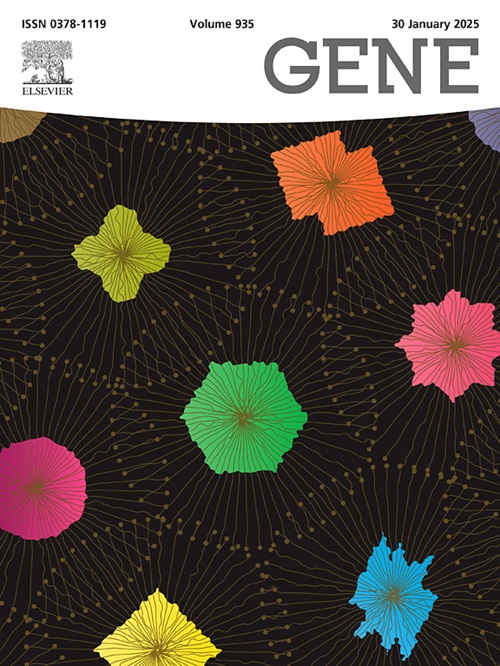半野生棉胚胎发育后期丰富的GhLEA-5基因正调控陆地棉耐盐性
IF 2.6
3区 生物学
Q2 GENETICS & HEREDITY
引用次数: 0
摘要
盐胁迫严重影响棉花的产量和品质。本研究分离了异源四倍体陆地棉(Gossypium hirsutum L.)和半野生棉(Gossypium purpurascens)胚胎发育晚期丰富基因家族GhLEA_5A/D (Gh_A10G166600和Gh_D10G188300)的全长编码区和基因组DNA序列,并对其耐盐性进行了实验验证。序列比对和系统发育树分析表明,GhLEA-5A与GhLEA-5D具有显著的同源性。此外,在这些序列中一致鉴定出保守的蛋白质基序。转录组数据分析表明,与盐敏感材料相比,耐盐紫癜叶片中GhLEA-5A/D的表达水平显著提高。在实时定量反转录PCR (qRT-PCR)检测中,在盐胁迫下3和12小时的时间点,在耐盐陆地棉材料中检测到GhLEA-5D基因的显著表达水平。通过病毒诱导基因沉默(VIGS)技术抑制GhLEA-5A/D转录显著加剧了棉花的盐敏感性。与对照组相比,经过盐处理的植物中丙二醛(MDA)含量增加了近50%,过氧化物酶(POD)水平降低了60%,这证明了这一点。GhLEA-5A/D基因的过度表达增强了拟南芥的耐盐性,导致根长增加25%,存活率提高30%,保水能力增加15%,光合效率提高15%。叶绿素荧光参数、酶活性、二氨基苯和硝基蓝四氮唑染色表明,ghea - 5a /D可能在棉花对盐胁迫的响应中发挥了积极的调节作用。此外,我们在酵母双杂交筛选文库中鉴定了76个可能与GhLEA-5相互作用的候选蛋白。这些结果为研究棉花耐盐机理提供了理论依据,并为棉花耐盐基因的改良提供了新的资源。本文章由计算机程序翻译,如有差异,请以英文原文为准。
Late embryogenesis abundant gene GhLEA-5 of semi-wild cotton positively regulates salinity tolerance in upland cotton
The productivity and quality of cotton are significantly compromised by salt stress. In this study, the full length of encoding region and genomic DNA sequences of GhLEA_5A/D (Gh_A10G166600 and Gh_D10G188300), which belong to the late embryogenesis abundant gene family in allotetraploid upland cotton (Gossypium hirsutum L.) and semi-wild cotton (Gossypium purpurascens), were isolated and their salt tolerance was experimentally confirmed. Analysis of sequence alignments and phylogenetic trees indicated a significant level of homology between GhLEA-5A and GhLEA-5D. Additionally, a conserved protein motif was consistently identified across these sequences. The transcriptome data analysis showed that the expression level of GhLEA-5A/D was substantially enhanced in the leaves of salt-tolerant G. purpurascens accessions compared to salt-sensitive materials. In the real-time quantitative reverse transcription PCR (qRT-PCR) assays, notable expression levels of the GhLEA-5D gene were detected in salt-tolerant upland cotton materials following exposure to salt stress at 3 and 12-hour time points. The suppression of GhLEA-5A/D transcription via Virus-induced Gene Silencing (VIGS) technology significantly exacerbates salt sensitivity in cotton. This is evidenced by the nearly 50 % increase in malondialdehyde (MDA) content alongside a 60 % reduction in peroxidase (POD) levels in salt-treated plants when compared to the control group. The overexpression of the GhLEA-5A/D gene conferred enhanced salt tolerance in Arabidopsis, resulting in a 25 % increase in root length, a 30 % improvement in survival rate, a 15 % increase in water retention, and a 15 % boost in photosynthetic efficiency. The chlorophyll fluorescence parameters, enzyme activities, diaminobenzine, and nitroblue tetrazolium staining suggested that GhLEA-5A/D likely exhibited a positive regulatory role for cotton responding to salt stress. Furthermore, we identified 76 candidate proteins that potentially interact with GhLEA-5 in the yeast two-hybrid screening library. These results provide a theoretical basis for studying the mechanism of cotton salt tolerance and offer new resources for improving cotton salt tolerance genes.
求助全文
通过发布文献求助,成功后即可免费获取论文全文。
去求助
来源期刊

Gene
生物-遗传学
CiteScore
6.10
自引率
2.90%
发文量
718
审稿时长
42 days
期刊介绍:
Gene publishes papers that focus on the regulation, expression, function and evolution of genes in all biological contexts, including all prokaryotic and eukaryotic organisms, as well as viruses.
 求助内容:
求助内容: 应助结果提醒方式:
应助结果提醒方式:


